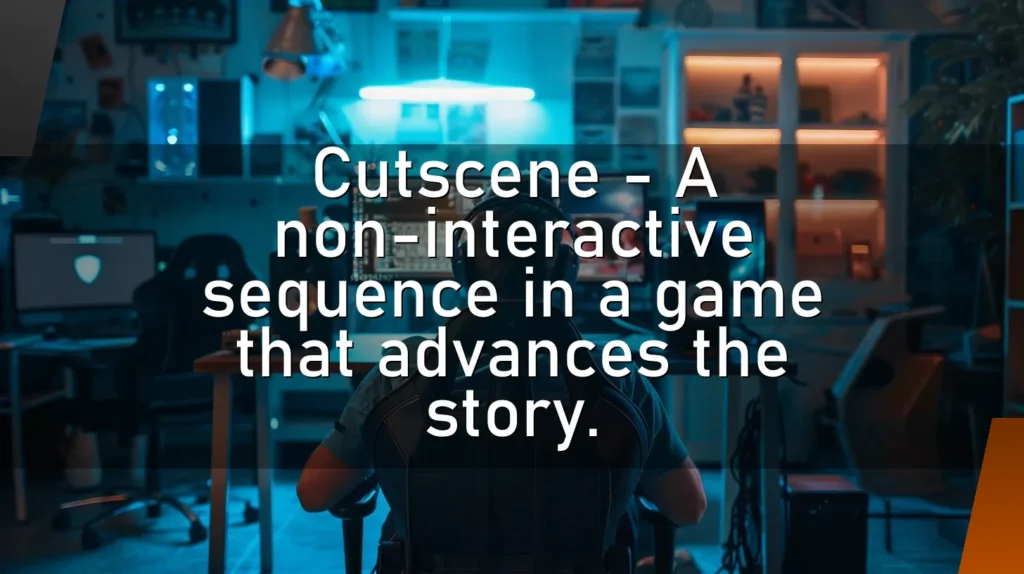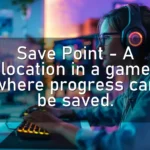Cutscene – A Non-Interactive Sequence in a Game That Advances the Story
Imagine you’re diving deep into a video game, slaying dragons, or maybe just furiously clicking through a dating sim. Suddenly, control is snatched away from you, and you’re thrust into a mini-movie. Welcome to the world of cutscenes! 🎬
How a Nerd Would Describe It
"Ah, the cutscene," a nerd might say, adjusting their glasses. "It’s like the game is saying, ‘You’ve had your fun with the joystick, now let me tell you a tale.’ It’s the part where you put down the controller and grab some popcorn 🍿, because the plot’s about to thicken."
Details
A cutscene is essentially a non-interactive sequence within a game designed to advance the story, develop characters, or provide background information. Think of it as the gaming equivalent of a TV show’s cold open.
Fun Fact: The term "cutscene" was first coined by game designer Ron Gilbert while working on the game Maniac Mansion in 1987. 🕹️
These sequences can range from simple text on a screen to full-blown cinematic experiences with voice acting, motion capture, and CGI. They’re the game developer’s way of ensuring that the story progresses in a controlled manner, without the unpredictable whims of player behavior.
Other Similar Words Which Nerds Use
- FMV (Full Motion Video): This term refers to live-action video sequences used in games, more common in the 90s. Think Command & Conquer series.
- In-Engine Cutscenes: These are cutscenes created using the game’s engine, often seamlessly transitioning from gameplay to story. Uncharted series, we’re looking at you. 👀
- Quick Time Events (QTEs): These are semi-interactive cutscenes where players must press buttons in a timely manner to influence the outcome. Ah, the bane of many a gamer’s existence, like in God of War. 😅
👍 Correct Usage
- "Wow, that cutscene really fleshed out the main character’s backstory!"
- "The graphics in that cutscene were top-notch!"
- "I love how the cutscenes in this game make me feel like I’m watching a movie!"
🛑 Wrong Usage
- "I can’t believe I died during that cutscene!" (Unless it’s a QTE, cutscenes are typically safe zones. 😉)
- "I skipped all the cutscenes and now I have no idea what’s going on." (Well, duh. They’re there for a reason! 🧐)
Conclusion
Cutscenes are the unsung heroes of storytelling in video games. They give players a breather, provide crucial plot points, and can be visually stunning. However, they can also be a double-edged sword. Here’s why:
Advantages:
- Storytelling: Provides a structured way to advance the plot and develop characters.
- Visual Splendor: Can showcase a game’s graphical capabilities.
- Emotional Impact: Well-crafted cutscenes can tug at your heartstrings. 😢
Disadvantages:
- Pacing: Too many or too long cutscenes can disrupt gameplay flow.
- Non-Interactive: Some players just want to play, not watch.
- Replayability: Repeated viewings of cutscenes can become annoying on subsequent playthroughs.
Pro Tip: If you’re new to a game, don’t skip the cutscenes. They’re there to help you understand the world you’re diving into. But if you’re on your fifth replay, we won’t judge you for hitting the skip button. 😉
The Evolution of Cutscenes
Back in the day, cutscenes were just blocks of text or simple animations. But as technology advanced, so did the ambition of game developers. Now, we have cutscenes that rival blockbuster movies. 🎥
Example: The Last of Us Part II features cutscenes with such high emotional and graphical fidelity that it feels like you’re watching a high-budget TV series.
Interactive Storytelling
Some games blur the lines between cutscenes and gameplay. Telltale Games’ series, like The Walking Dead, make the player’s choices during cutscenes impact the story. It’s like choose-your-own-adventure books on steroids! 💪
Technical Terms
- CGI (Computer-Generated Imagery): Used to create 3D graphics and animations in cutscenes.
- Motion Capture: Technology used to record the movements of actors to create realistic animations.
- Voice Acting: Professional actors provide voices for characters, adding depth to the narrative.
Why Do Developers Use Cutscenes?
- Control: Ensure crucial plot points are conveyed to the player.
- Emotional Impact: Allows for crafted emotional moments that gameplay alone might not achieve.
- Exposition: Provides background information and context.
The Future of Cutscenes
With the advent of VR (Virtual Reality) and AR (Augmented Reality), the future of cutscenes is even more immersive. Imagine being inside a cutscene, interacting with characters on a whole new level. The lines between gameplay and cutscenes are blurring more and more. 🤯
Conclusion
Cutscenes are like the seasoning in a well-cooked meal. Too much, and you ruin the dish; too little, and it’s bland. But just the right amount, and you’ve got a culinary masterpiece. 🍲
So the next time you’re about to skip that cutscene, remember: it’s not just filler. It’s the developers’ way of telling you, "Sit back, relax, and enjoy the show." 🎬
Keep on gaming, and may your cutscenes be ever epic! 🎮✨







